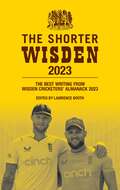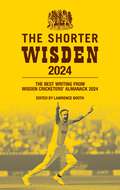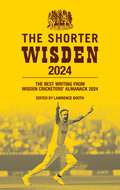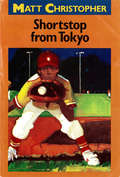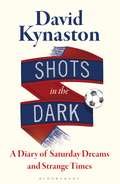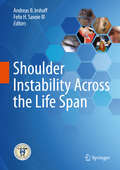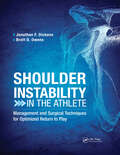- Table View
- List View
The Shorter Wisden 2023: The Best Writing from Wisden Cricketers' Almanack 2023
The most famous sports book in the world, Wisden Cricketers' Almanack has been published every year since 1864. The selected writings from the 160th edition contained in this eBook offer trenchant opinion, compelling features and an authoritative voice on the worldwide game.The Shorter Wisden is a compelling distillation of what's best in its bigger brother – and the 2023 edition of Wisden is crammed, as ever, with the best writing in the game. Wisden's digital version includes the influential Notes by the Editor, and all the front-of-book articles.In an age of snap judgments, Wisden's authority and integrity are more important than ever. Yet again this year's edition is truly a “must-have” for every cricket fan. In essence, The Shorter Wisden is a glass of the finest champagne rather than the whole bottle.@WisdenAlmanack
The Shorter Wisden 2024: The Best Writing from Wisden Cricketers' Almanack 2024
by John Wisden CoThe most famous sports book in the world, Wisden Cricketers' Almanack has been published every year since 1864. The selected writings from the 161st edition contained in this eBook offer trenchant opinion, compelling features and an authoritative voice on the worldwide game.The Shorter Wisden is a distillation of what's best in its bigger brother – and the 2024 edition of Wisden is crammed, as ever, with the best writing in the game. Wisden's digital version includes the influential Notes by the Editor, and all the front-of-book articles. In essence, The Shorter Wisden is a glass of the finest champagne rather than the whole bottle. In an age of snap judgments, Wisden's authority and integrity are more important than ever. Yet again this year's edition is truly a “must-have” for every cricket fan.@WisdenAlmanack
The Shorter Wisden 2024: The Best Writing from Wisden Cricketers' Almanack 2024
The most famous sports book in the world, Wisden Cricketers' Almanack has been published every year since 1864. The selected writings from the 161st edition contained in this eBook offer trenchant opinion, compelling features and an authoritative voice on the worldwide game.The Shorter Wisden is a distillation of what's best in its bigger brother – and the 2024 edition of Wisden is crammed, as ever, with the best writing in the game. Wisden's digital version includes the influential Notes by the Editor, and all the front-of-book articles. In essence, The Shorter Wisden is a glass of the finest champagne rather than the whole bottle. In an age of snap judgments, Wisden's authority and integrity are more important than ever. Yet again this year's edition is truly a “must-have” for every cricket fan.@WisdenAlmanack
The Shorter Wisden India Almanack 2014
by Bloomsbury PublishingWisden has grown through the years to embrace innovation and maintain its status as the most revered and cherished brand in cricket. The 'Bible of Cricket', Wisden Cricketers' Almanack has been published every year since 1864. Wisden's Cricketers of the Year Awards, one of the oldest honours in the sport, dates back to 1889. The Almanack, known for editorial excellence, has been a perennial bestseller in the UK. The second edition with India-specific content is even more engrossing. Contributors include Bishan Singh Bedi, Anil Kumble, Mahele Jayawardhene, Sanjay Manjrekar, Shashi Tharoor, Gideon Haigh, Kamila Shamsie, Shehan Karunatilaka, Rahul Bhattacharya and many others…
Shortstop from Tokyo
by Matt ChristopherWhen the new boy from Tokyo takes over Stogie Crane's position as shortstop, the two boys encounter the first of several barriers to their friendship.
The Shotgun Conservationist: Why Environmentalists Should Love Hunting
by Brant MacDuffBrant MacDuff's personal journey from staunch anti-hunter to compassionate, ethical hunter weaves a larger story about humans, animals, the environment, and our food systems.
The Shotokan Karate Bible 2nd edition: Beginner to Black Belt
by Ashley P. MartinAn authoritative text supporting the newcomer to karate with all they need to know, up to black belt level.Packed with photographs detailing techniques and kata (the combinations of techniques students need to master to progress through the belts) this book is designed to take the student step by step through the progression of Shotokan Karate, taking each belt in turn. Photographs and clear instructions take you step by step through the kata. Karate is a martial art that focuses on the application of strikes using predominantly the hands and feet. It originated in Japan and has become popular throughout the world. There are many styles of karate but the most widely practised outside of Japan is Shotokan Karate. Training in karate is normally divided into three sections: the basic technique; kata, or sequencing of techniques to imaginary opponents; and kumite, the sparring done with an opponent. In total there are ten gradings to be passed in order to get a black belt - this, on average takes a student four years to attain. This book covers all the training needed to attain a black belt.This new edition includes brand new material on partner work, more grading tips to help you avoid making common mistakes, and new footwork diagrams to help you understand the movements better. An indispensable guide.
The Shotokan Karate Bible 2nd edition: Beginner to Black Belt
by Ashley P. MartinAn authoritative text supporting the newcomer to karate with all they need to know, up to black belt level.Packed with photographs detailing techniques and kata (the combinations of techniques students need to master to progress through the belts) this book is designed to take the student step by step through the progression of Shotokan Karate, taking each belt in turn. Photographs and clear instructions take you step by step through the kata. Karate is a martial art that focuses on the application of strikes using predominantly the hands and feet. It originated in Japan and has become popular throughout the world. There are many styles of karate but the most widely practised outside of Japan is Shotokan Karate. Training in karate is normally divided into three sections: the basic technique; kata, or sequencing of techniques to imaginary opponents; and kumite, the sparring done with an opponent. In total there are ten gradings to be passed in order to get a black belt - this, on average takes a student four years to attain. This book covers all the training needed to attain a black belt.This new edition includes brand new material on partner work, more grading tips to help you avoid making common mistakes, and new footwork diagrams to help you understand the movements better. An indispensable guide.
The Shotokan Karate Bible 2nd edition: Beginner to Black Belt
by Ashley P. MartinAn authoritative text providing the newcomer to karate with all they need to know. Packed with clear photographs detailing techniques and kata (the combinations of techniques students must master to progress through the belts), this book is organized and designed to take the student step-by-step through the progression of the martial art, taking each belt in turn. Photographs are accompanied by clear instructions from the author, a trained instructor with his own karate school. Karate is a martial art that focuses on the application of strikes using the hands and feet. It originated in Japan and has become popular throughout the world. There are many styles of karate but the most widely practiced outside of Japan is Shotokan. Training in karate is normally divided into three sections: the basic technique; kata, or sequencing of techniques to imaginary opponents; and kumite, the sparring done with an opponent. Gradings are the exams needed to progress to the next level. Typically, three months is needed to progress through each grading. There are usually three or four gradings per year, each with a syllabus. In total a student must passten gradings in order to get a black belt--this, on average, takes a student four years to attain. Packed with useful how-to diagrams and guides on technique, this book covers the training required to attain a black belt.
Shots in the Dark: A Diary of Saturday Dreams and Strange Times
by David KynastonBrimming with wisdom and humour, David Kynaston's diaries written over one football season offer up his most personal take on social history to date.David Kynaston was seven and a half years old when he attended his first Aldershot match in the early months of 1959. So began a deep attachment to the game and a lifelong loyalty to an obscure, small-town football club. Though as he sits down to write his diaries almost sixty years on, he reflects that life might have been simpler if his father had never taken him to that first match at the Rec… Shots in the Dark is the diary David Kynaston kept in the football season of 2016/17, detailing the ups and downs of the 'Shots' in the year that saw a divisive referendum in the UK and the impending ascension of Donald Trump. Here Kynaston presents a social history of modern Britain with a difference – all through the prism of the beautiful game. A testament to the ways in which fandom gives solidity and security to our lives, particularly in these bewildering and rapidly changing times, Shots in the Dark gets to the heart of what it means to be a devoted follower of a sports team. This is a diary of the macro and the micro, as questions of loyalty, of identity, of liberalism and of nationalism all rub uncomfortably up against each other during nine charged months.
Shots in the Dark: A Diary of Saturday Dreams and Strange Times
by David KynastonBrimming with wisdom and humour, David Kynaston's diaries written over one football season offer up his most personal take on social history to date.David Kynaston was seven and a half years old when he attended his first Aldershot match in the early months of 1959. So began a deep attachment to the game and a lifelong loyalty to an obscure, small-town football club. Though as he sits down to write his diaries almost sixty years on, he reflects that life might have been simpler if his father had never taken him to that first match at the Rec… Shots in the Dark is the diary David Kynaston kept in the football season of 2016/17, detailing the ups and downs of the 'Shots' in the year that saw a divisive referendum in the UK and the impending ascension of Donald Trump. Here Kynaston presents a social history of modern Britain with a difference – all through the prism of the beautiful game. A testament to the ways in which fandom gives solidity and security to our lives, particularly in these bewildering and rapidly changing times, Shots in the Dark gets to the heart of what it means to be a devoted follower of a sports team. This is a diary of the macro and the micro, as questions of loyalty, of identity, of liberalism and of nationalism all rub uncomfortably up against each other during nine charged months.
Shoulder and Elbow Injuries in Athletes: Prevention, Treatment and Return to Sport E-Book
by Robert A. Arciero Frank A. Cordasco Matthew T ProvencherThorough and concise, this practical reference provides a unique, on-field management approach to all athletic injuries to the shoulder and elbow, as well as nonoperative and operative treatment options, including arthroscopy and open surgery. Focusing on high-performance athletes, leading authorities in the field demonstrate how to provide pain relief, restore function, and return the athlete to sport and to prior level of performance in a safe and timely fashion.Showcases the knowledge and expertise of an international group of editors and authors who have served as president of the American Orthopaedic Society for Sports Medicine, the American Shoulder and Elbow Surgeons and the Arthroscopy Association of North America, are physicians or consultants for professional and collegiate sports teams, have won awards for research in the field of shoulder surgery, are editors and reviewers for peer-reviewed journals, and much more. Contains rehabilitation guidelines and critical return-to-sport protocols – essential information for nonsurgical healthcare providers -- primarily on athletes under the age of 40, with some consideration of the older athlete (professional golf, for example). Contains a section in each chapter covering "On-the-Field Management and Early Post-Injury Assessment and Treatment" – a must-read for immediate care of the injured athlete and ensuring the safe return to play. Covers the most recent advances in the management of tendon tears in elite and overhead athletes, including prevention in youth sports, early sports specialization, and changing standards of care regarding shoulder and elbow instability. Provides a thorough review of current ulnar collateral ligament injury diagnosis, imaging, non-operative management, and surgery, as well as acromioclavicular and sternoclavicular joint injuries, clavicle and olecranon fractures, and OCD of the capitellum.
Shoulder Arthroplasty
by Louis U. Bigliani Evan L. FlatowA practical and richly illustrated step-by-step guide to successfully performing shoulder arthroplasty. The comprehensive text covers various topics, and also provides specific examples of complications and how to avoid and correct them.
Shoulder Arthroscopy: How to Succeed!
by Olivier CourageThis book has been designed to lead you through the first steps of the shoulder arthroscopy. Offering a companion guide, its numerous illustrations and videos support the text and aid in comprehension.The most common mistake in shoulder arthroscopy is to focus on the screen, whereas an external perspective is needed, though not always easy to achieve in practice. We recommend following the chronological order for the first techniques, which are then detailed one by one and can be read separately depending on the problem encountered. These techniques, all of which were developed by the author in the course of 20 years of arthroscopic surgeries, are characterized by their simplicity. After having mastered these techniques, the reader will have the basis needed to evolve on his or her own.
Shoulder Arthroscopy: Principles and Practice
by Giuseppe Milano Andrea GrassoShoulder Arthroscopy – Principles and Practice is a comprehensive and fully up-to-date work covering all major shoulder problems and related arthroscopic treatments. Two sections on basic science and principles of shoulder arthroscopy will provide essential information to build primary knowledge on shoulder arthroscopy issues. Shoulder problems and related treatments will be described according to a learning pathway, which will allow the readers to improve their knowledge and skills in shoulder arthroscopy from simple, standardized techniques to more complex and advanced procedures. All chapters will be written by expert arthroscopic surgeons who will provide decision-making algorithms for diagnosis and treatment of shoulder disorders, step-by step-instructions on arthroscopic techniques, and technical “tips & pearls” on how they would perform the procedure. Dedicated section on outcome measurements will help readers in learning principles of outcome research on the topics of the book.
Shoulder Arthroscopy: Principles and Practice
by Giuseppe Milano Andrea Grasso Roman Brzóska Ladislav KovačičThis comprehensive textbook, published in collaboration with ESSKA, now in a revised and updated second edition, covers all major shoulder problems and related arthroscopic treatments. Introductory sections on basic science and the principles of shoulder arthroscopy provide essential information with the aim of enhancing understanding of a wide range of key issues. Shoulder conditions and their treatments are then described according to a learning pathway that will allow readers to improve their knowledge and skills in shoulder arthroscopy, from simple, standardized techniques to more complex and advanced procedures. The new edition includes additional chapters and offers attractive recent surgical solutions to challenging shoulder conditions, such as severe bone loss in shoulder instability and massive and irreparable rotator cuff tears. All chapters are written by expert arthroscopic surgeons who present decision-making algorithms for diagnosis and treatment, provide step-by-step instructions on arthroscopic techniques, identify pitfalls, and describe their personal tips and pearls. A dedicated section on outcomes measurements and experimental models explains the principles of outcome research on the topics addressed in the book.
Shoulder Concepts 2013: Proceedings of the ISAKOS Upper Extremity Committees 2009-2013
by Guillermo Arce, Klaus Bak, Kevin P Shea, Felix Savoie III, William Benjamin Kibler, Eiji Itoi, Augustus D. Mazzocca, Knut Beitzel, Emilio Calvo and Benno EjnismanThis booklet is intended as an insightful update on daily shoulder management closely based on the content of closed consensus meetings of the International Society of Arthroscopy, Knee Surgery and Orthopaedic Sports Medicine (ISAKOS) Upper Extremity Committee (UEC). Section A provides a comprehensive review of the currently available classifications and outcome scores for shoulder disorders, illustrating their potential pitfalls and limitations. The authors emphasize the need for standardization of shoulder assessment and propose two novel classifications that are expected to facilitate tailoring of management. Section B describes pioneering techniques to re-establish shoulder function after dislocation of the acromio-clavicular joint and covers surgical indications and decision-making criteria. Section C describes the current state of evidence concerning rotator cuff disorders, providing novel theories regarding the underlying biomechanics and reconstruction techniques.
Shoulder Instability: A Comprehensive Approach
by Matthew T Provencher Anthony A RomeoShoulder Instability, by Drs. Mark Provencher and Anthony Romeo, is the first comprehensive resource that helps you apply emerging research to effectively manage this condition using today’s best surgical and non-surgical approaches. Detailed illustrations and surgical and rehabilitation videos clearly demonstrate key techniques like bone loss treatment, non-operative rehabilitation methods, multidirectional instability, and more. You’ll also have access to the full contents online at www.expertconsult.com. Watch surgical and rehabilitation videos online and access the fully searchable text at www.expertconsult.com. Stay current on hot topics including instability with bone loss treatment, non-operative rehabilitation methods, multidirectional instability, and more. Gain a clear visual understanding of the treatment of shoulder instability from more than 850 images and illustrations. Find information quickly and easily with a consistent format that features pearls and pitfalls, bulleted key points, and color-coded side tabs. Explore shoulder instability further with annotated suggested readings that include level of evidence. State-of-the-art, comprehensive resource for the surgical and non-surgical treatment of shoulder instability
Shoulder Instability Across the Life Span
by Andreas B. Imhoff Felix H. Savoie IIIThis book outlines the consensus findings of the ISAKOS Upper Extremity Committee regarding the treatment options for patients suffering from shoulder instability. The aim is to furnish readers with a precise knowledge of the presenting features of conditions typical of different ages, thereby facilitating assessment of patient characteristics and optimal treatment decision making based on the consensus of the Committee. All age groups are covered, from the very young through to the older patient. The structuring of the book essentially according to age group reflects the fact that certain forms of shoulder instability are observed at different ages. For example, while young patients tend to demonstrate instability combined with hyperlaxity, in later years, bony defects of the glenoid and humerus gain in importance. Similarly, the scope for conservative treatment varies across the life span. Each management-oriented chapter of the book includes information and guidance on anatomy, clinical examination, imaging, surgical indications and technique, rehabilitation, outcomes, and complications and their avoidance, and the text is supported by numerous high-quality illustrations.
Shoulder Instability in the Athlete: Management and Surgical Techniques for Optimized Return to Play
by Jonathan Dickens Brett OwensShoulder Instability in the Athlete: Management and Surgical Techniques for Optimized Return to Play is a groundbreaking text that covers all aspects of care for athletes with shoulder instability—from on-the-field management and treatment to successful return to play. Edited by Drs. Jonathan F. Dickens and Brett D. Owens and featuring the expertise of internationally recognized surgeons who specialize in shoulder instability in high-level athletes, Shoulder Instability in the Athlete is a unique collaboration applicable across a variety of professional areas. This will be the premiere reference for physicians, surgeons, therapists, trainers, and students involved in the care of athletes. Each chapter of Shoulder Instability in the Athlete reviews cutting-edge clinical and surgical techniques, as well as outcomes and return to play criteria. In-depth analysis of appropriate literature and outcomes specific to the athlete population are also presented. Important sections within the text include: Principles for the team physician Anterior instability Posterior instability Special topics in instability By focusing specifically on the unique and challenging dilemma of caring for the athlete with shoulder instability, Shoulder Instability in the Athlete will be a valuable reference for all health professionals who manage athletes.
Shoulder Instability in the Athlete: Management and Surgical Techniques for Optimized Return to Play
by Jonathan Dickens Brett OwensShoulder Instability in the Athlete: Management and Surgical Techniques for Optimized Return to Play is a groundbreaking text that covers all aspects of care for athletes with shoulder instability—from on-the-field management and treatment to successful return to play. Edited by Drs. Jonathan F. Dickens and Brett D. Owens and featuring the expertise of internationally recognized surgeons who specialize in shoulder instability in high-level athletes, Shoulder Instability in the Athlete is a unique collaboration applicable across a variety of professional areas. This will be the premiere reference for physicians, surgeons, therapists, trainers, and students involved in the care of athletes. Each chapter of Shoulder Instability in the Athlete reviews cutting-edge clinical and surgical techniques, as well as outcomes and return to play criteria. In-depth analysis of appropriate literature and outcomes specific to the athlete population are also presented. Important sections within the text include: Principles for the team physician Anterior instability Posterior instability Special topics in instability By focusing specifically on the unique and challenging dilemma of caring for the athlete with shoulder instability, Shoulder Instability in the Athlete will be a valuable reference for all health professionals who manage athletes.
Shoulder stand yoga posture (large print)
by Rnib BookshareThis image can only give an insight into what yoga is. It cannot be used alone as a training / user guide. The posture is only one from hundreds of possibilities and cannot be used in isolation. Yoga must be taught with breathing exercises and sequencing of postures. Each posture involves a timed procedure of movement, breathing and focused thought, not a static exercise position. There are two images of a side view of woman, separated by a dashed line on the page. There is a locator dot shown which will be in the top left of the page when the image is the correct way up. The image on the left of the page is the full shoulder stand posture. The woman wears a vest and leggings. In the bottom centre of the image is the woman's head looking up. The top of her head is to the left. To the right of her head her shoulders are flat on the floor. Her upper body bends from the neck and shoulders up and to the right. Her legs bend at right angles to her body to the left and up. The legs are straight and the toes pointed in the direction of the leg. The image on the right of the page is the easy or beginner's shoulder stand posture. She also wears a vest and leggings. In the bottom centre of the image is the woman's head looking up. The top of her head is to the left. To the right of her head her shoulders are flat on the floor. Her upper body bends from the neck sharply up vertically. Her legs are straight and go vertically up with the toes pointed in the direction of the leg.
Shoulder stand yoga posture (UEB contracted)
by Rnib BookshareThis image can only give an insight into what yoga is. It cannot be used alone as a training / user guide. The posture is only one from hundreds of possibilities and cannot be used in isolation. Yoga must be taught with breathing exercises and sequencing of postures. Each posture involves a timed procedure of movement, breathing and focused thought, not a static exercise position. There are two images of a side view of woman, separated by a dashed line on the page. There is a locator dot shown which will be in the top left of the page when the image is the correct way up. The image on the left of the page is the full shoulder stand posture. The woman wears a vest and leggings. In the bottom centre of the image is the woman's head looking up. The top of her head is to the left. To the right of her head her shoulders are flat on the floor. Her upper body bends from the neck and shoulders up and to the right. Her legs bend at right angles to her body to the left and up. The legs are straight and the toes pointed in the direction of the leg. The image on the right of the page is the easy or beginner's shoulder stand posture. She also wears a vest and leggings. In the bottom centre of the image is the woman's head looking up. The top of her head is to the left. To the right of her head her shoulders are flat on the floor. Her upper body bends from the neck sharply up vertically. Her legs are straight and go vertically up with the toes pointed in the direction of the leg.
Shoulder stand yoga posture (UEB uncontracted)
by Rnib BookshareThis image can only give an insight into what yoga is. It cannot be used alone as a training / user guide. The posture is only one from hundreds of possibilities and cannot be used in isolation. Yoga must be taught with breathing exercises and sequencing of postures. Each posture involves a timed procedure of movement, breathing and focused thought, not a static exercise position. There are two images of a side view of woman, separated by a dashed line on the page. There is a locator dot shown which will be in the top left of the page when the image is the correct way up. The image on the left of the page is the full shoulder stand posture. The woman wears a vest and leggings. In the bottom centre of the image is the woman's head looking up. The top of her head is to the left. To the right of her head her shoulders are flat on the floor. Her upper body bends from the neck and shoulders up and to the right. Her legs bend at right angles to her body to the left and up. The legs are straight and the toes pointed in the direction of the leg. The image on the right of the page is the easy or beginner's shoulder stand posture. She also wears a vest and leggings. In the bottom centre of the image is the woman's head looking up. The top of her head is to the left. To the right of her head her shoulders are flat on the floor. Her upper body bends from the neck sharply up vertically. Her legs are straight and go vertically up with the toes pointed in the direction of the leg.
